FOF Best of 2023
Updated: Mar 14
A TOY DOLL, A DESTROYER OF WORLDS, AND THE WHO'S WHO
OF AUTEUR RELEASES IN 2023
There is a popular gif circulating around the interwebs these days which is particularly nostalgic to me in regards to the music of my youth. It's a stack of cassette tapes from the likes of Metallica, Pearl Jam, GNR, Nirvana, Soundgarden, and the Chili Peppers. The tapes are arranged haphazardly, and the photo even looks fuzzy like the kind we took in the 90's. Its caption reads something like, "These were all released within 44 days of each other in 1991." Well, film friends, in many ways that's this movie year.
Due to the happenstances of fortuity (or, you know, the countless COVID delays in production finally coming full circle), every major auteur from the last 50 years and his (or her) brother put out a picture this year. Scorsese. Fincher. Gerwig. Nolan. Schrader. Haynes. Yorgos. Coppola the Younger. Aster. Mann. On and on. Even Mr. I’ve Made Four Films in Two Decades himself, Jonathan Glazer, dropped a, well, work of aural wonder on our laps.

Of course, the largest difference between these flicks and those old cassettes is that some of the former were less than top shelf. And, while maybe you’re the rare cat who rides for Vitalogy or Insecticide, Ten and Nevermind are pretty unimpeachable works of grunge mastery. Still, though most films weren’t minted platinum, it’s also true that the majority were actually quite solid! Some, in fact, are late period wonderworks from aging masters.
Which leads us to the craziest fact of ALL, namely that the predominant conversation around the filmic “cooler” was hardly about this veritable who’s who at all! No, instead, we smashed two disparate movies together, rolled out our very best gender essentialist takes, and created a portmanteau for the ages. Say it with me on the count of 3….BARBENHEIMER! Ooooh, just got chills. Look, whatever else you want to say about all the memes and social media upheaval, these two behemoths mutually benefited from the fanfare. And when you throw 20 works of past masters and a pair of billion dollar plus juggernauts into the ring together, you come out with the best movie year since ‘19. Without further ado, here's my top 20 of that batch.

# 20 Spider-Man:
Across the Spider-Verse
Spider-Man: Across the Spider-Verse is perhaps the most mesmerizing single work of animation I have ever seen. It pushes the boundaries of visual storytelling to new heights by seamlessly melding almost a dozen styles of animation. Some images almost sweep in and out with Impressionistic flourishes, like a Monet painting. Others seep into the background like water colors. Far more reflect the more 2-D sensibilities of the comics era from which the character arose. The combination of all of these different palettes in a SINGLE work is what is truly innovative and breathtaking. This is why this version of Spidey made my list.
And YET, despite its creative prowess, Across the Spider-Verse grapples with the challenge of being a middle film in a trilogy. Sure, it plays well as a stage-setter for a future installment. But with two massive hanging chads in its plot beats, I was left yearning for a more satisfying standalone arc. (In particular, I wondered why the dazzling villain all but disappeared in the third act.) This is why this version of Spidey is in last place. Still, all in all, a groundbreaking achievement in animation and a thrilling ride in its own right.

#19 Master Gardener
In Master Gardener, I’m as interested in the man behind the lens as the skinhead turned grand horticulturalist in the center of the frame. If you don’t know Paul Schrader, let me give you a brief primer. The man wrote Taxi Driver when he was 26 and broke. A few years later, he penned Raging Bull for that same director, a fella named Marty who seemed to have something. Eventually Mr. Schrader picked up the camera alongside the quill and began directing a series of pictures through the 80’s and beyond. Some are fairly well known (American Gigolo, Mishima) and others far less so (Hardcore, Light Sleeper), but all bear the same thematic heft of often isolated, troubled men confronting existential crises like guilt and the question of salvation.
So now here we are decades later and Paul has completed a trilogy of sorts, which he’s dubbed the “lonely man in the room.” While First Reformed may be the stone-cold masterpiece of the bunch, Master Gardener is a heck of a work in its own right. A quiet man with a violent past, Edgerton is terrific as a fastidious gardener in pursuit of order amidst the entropy of a broken world. He’s found a way to make something beautiful of the dung in his life. That is, until his wealthy employer’s African-American great niece shows up in need of mentoring. Will the past come back to haunt him, or in our most creative imagination, is there an available path to redemption?

#18 Still: A Michael J. Fox Movie
STILL: A Michael J. Fox Movie is one of the most powerful documentaries I’ve ever witnessed. It’s the tale of an incredibly charismatic man who has been allowed to tell his own story on HIS own terms (what a novel concept)! Directed with IMPECCABLE precision, the doc captures Michael J. Fox in the most authentic, heartfelt, yet non-cloying light imaginable. In fact, it is Fox’s own charisma and light on his feet humor which prevent this whole affair from ever veering into sentimentality.
Instead, through a skillful blend of direct-to-camera takes (from a man whose wit and demureness are still larger than life), expertly written voiceovers, and clever fourth-wall breaking moments, director David Guggenheim weaves together a captivating narrative that immerses viewers in the actor’s world. The inclusion of footage from actual 80s TV and films adds depth and nostalgia to the storytelling, elevating the whole project to a level of unparalleled excellence. STILL stands as a Herculean feat of editing and a testament to the resilience and spirit of one of Hollywood's most beloved icons.

#17 Blackberry
There’s no sense beating around the bush. Here’s my take – Blackberry is the film Air WISHES it could be. By this I mean, it’s the very best of the whole bunch of Capitalist underdog stories which came out this past year. (Nike? GameStop? Freaking Cheetos?!) Whereas Air is built on the backs of big name actors playing, well, pretty much versions of themselves with slightly different gaits or haircuts, Blackberry involves a trio of lived-in and embodied performances. I didn’t believe for a second that Ben Affleck was Phil Knight, for instance, but Glenn Howerton’s apoplectic blowhard take on Jim Balsillie was funny and unnerving in equal measure.
I am certainly aware that the two stories differ in terms of narrative arc as well, one being a rise and fall tale while the other just takes flight. (Jumpman! Jumpman)! But I’m speaking more to the actual construction of something nuanced and really born of a time. Blackberry does not have the goosebump-inducing final Matt Damon monologue, but it does grant us Matt Johnson, the goofy sidekick with cool band t-shirts, and Jay Baruchel as an impressively convincing egghead techy behind the whole operation. I laughed a good bit. I really FELT their pain even more. For these real-life stories turned popcorn flicks, that’s an august breadth of experience.
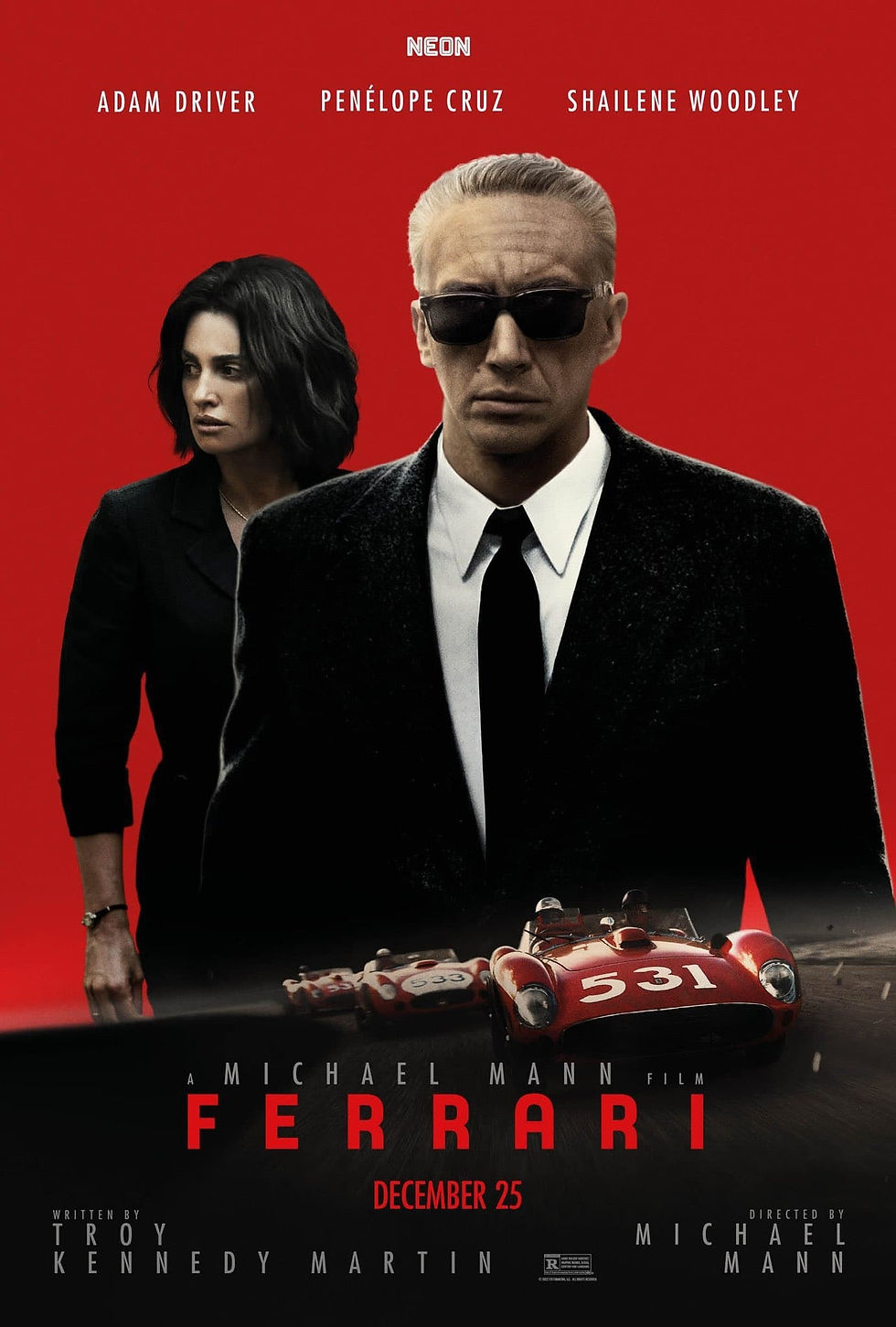
#16 Ferrari
JUSTICE FOR PENELOPE CRUZ! Seriously. What is actually happening in this Twilight Zone episode of Oscar nominations?? Look, Ferrari is a triumphant return to the fast lane (oh yeah, get ready. More car puns are on the way) for legendary director Michael Mann. The film showcases his signature punctiliousness in a picture that finally returns to his classic filmmaking roots. Besides remarkable set designs, Ferrari delivers some of the most breathtaking car racing sequences ever captured onscreen. We’re talking dash-cam mounted viscera alongside bucolic Italian countrysides. Who could ask for more?
Well, we could, as a matter of fact. Many of us have been imploring Mann for greater depth in his presentation of female characters for years, and with Ferrari, we finally got it. Adam Driver (pun kinda intended) is fabulous as the titular character whose presence and shadow hang over the whole affair, but it’s the luminous Penelope Cruz who carries this thing. Mann and Erik Messerschmidt give her a TON of closeups, as we watch her seethe with inner rage, channel fortified grit, remain loyal to a fault, and transcend a mother’s grief across the film’s brisk two hour runtime.
But with all these splendid new features, Mann's old focus on the theme of masculine obsession with the pursuit of greatness remain. While Ferrari may stumble into some sports biopic tropes and CGI limitations, its gripping crash sequences and profound reflections on the consequences of ambition make it a compelling ride (ba dun cha!) from start to finish. Oh, and Shailene Woodley is GODAWFUL as an Italian mistress. Just sayin'.
-Check out a full video review on our youtube channel here.
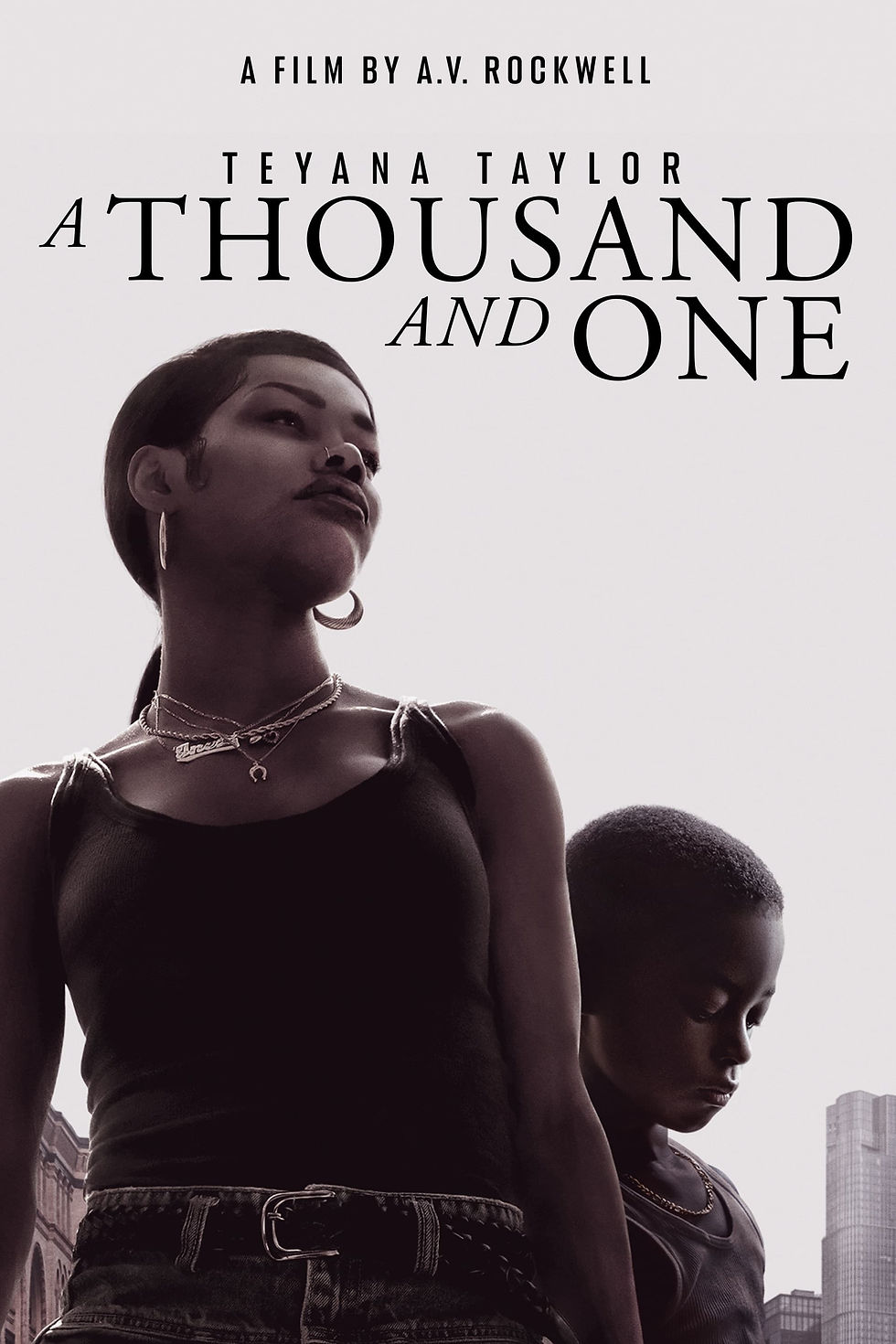
#15 A Thousand and One
Here’s a film that actually succeeds where so many other pictures across the indie drama landscape fall short. That is, in offering a raw and powerful portrayal of ordinary people grappling with everyday struggles. A Thousand and One is a film entirely uncluttered with the detritus of cliches yet somehow gripping in its commonplace details. This is due in no small part to the sturdy anchor of Teyana Taylor’s performance, which is the prism through which the film refracts themes of motherhood, gentrification, and our internal sense of “neighborhood.” Taylor’s story functions as a microcosm of the economic struggles of black lower-class Americans battling against changing real estate landscapes and the indifference of urban police writ large.
Now, this is not to say that Rockwell’s directorial debut is perfect, by any means. At times the plot feels thin, and the ending is certainly a wallop which will shock some and confound many others. It is also a rather abrupt finale to an otherwise grounded tale. Still, whatever else you can say about AV Rockwell, she is certainly making CHOICES. She has crafted a picture with beautiful imagery and storytelling, like something you’d see from the likes of Barry Jenkins. Though flawed in the ways that debut features often are, A Thousand and one remains a captivating journey which will leave viewers deeply invested in the lives of its characters.
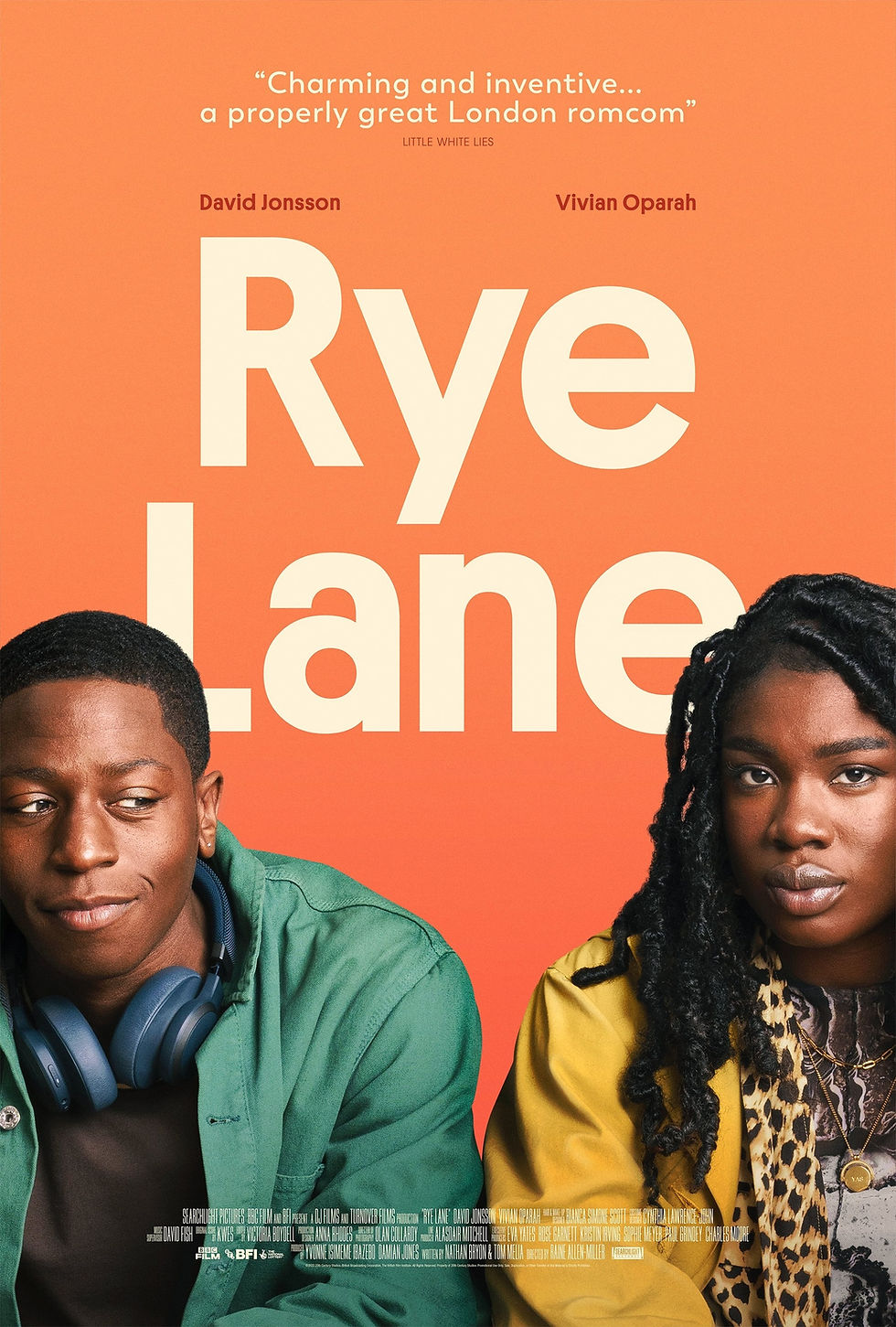
#14 Rye Lane
What do you get when you combine the coincidental meet-cute of strangers in a big city turned walk-and-talk exploration of life’s bigger questions a la Before Sunrise with the visual pyrotechnics of Amelie (read: fish-eyed lens galore and hyperkinetic cutting), only set in South London with all the wondrous cuisine and regional dialect that entails? Well. Apparently, a masterwork that almost no one effing watched! This is genuinely mind-boggling to me.
On the one hand, Rye Lane is doing almost nothing new in the romcom genre. Yet, it’s craftily blending familiar elements with visual storytelling and snappy dialogue to create a punchy cinematic experience. Yas and Dom's journey through the streets of South London is a delight to watch, as they navigate heartbreak and rediscover the possibility of romance in unexpected places. Director Raine Allen-Miller gifts us a veritable scrapbook of poignant images, capturing the essence of the city and its inhabitants with vibrant energy and genuine emotion. David Jonsson and Vivian Oparah deliver standout performances, bringing charisma to their roles and forming a captivating on-screen chemistry that keeps viewers invested from start to finish. Oh and did I mention it’s funny, tender, and ONLY 77 MINUTES LONG?! Yeah, get on this one.
-Check out a full video review on our youtube channel here.
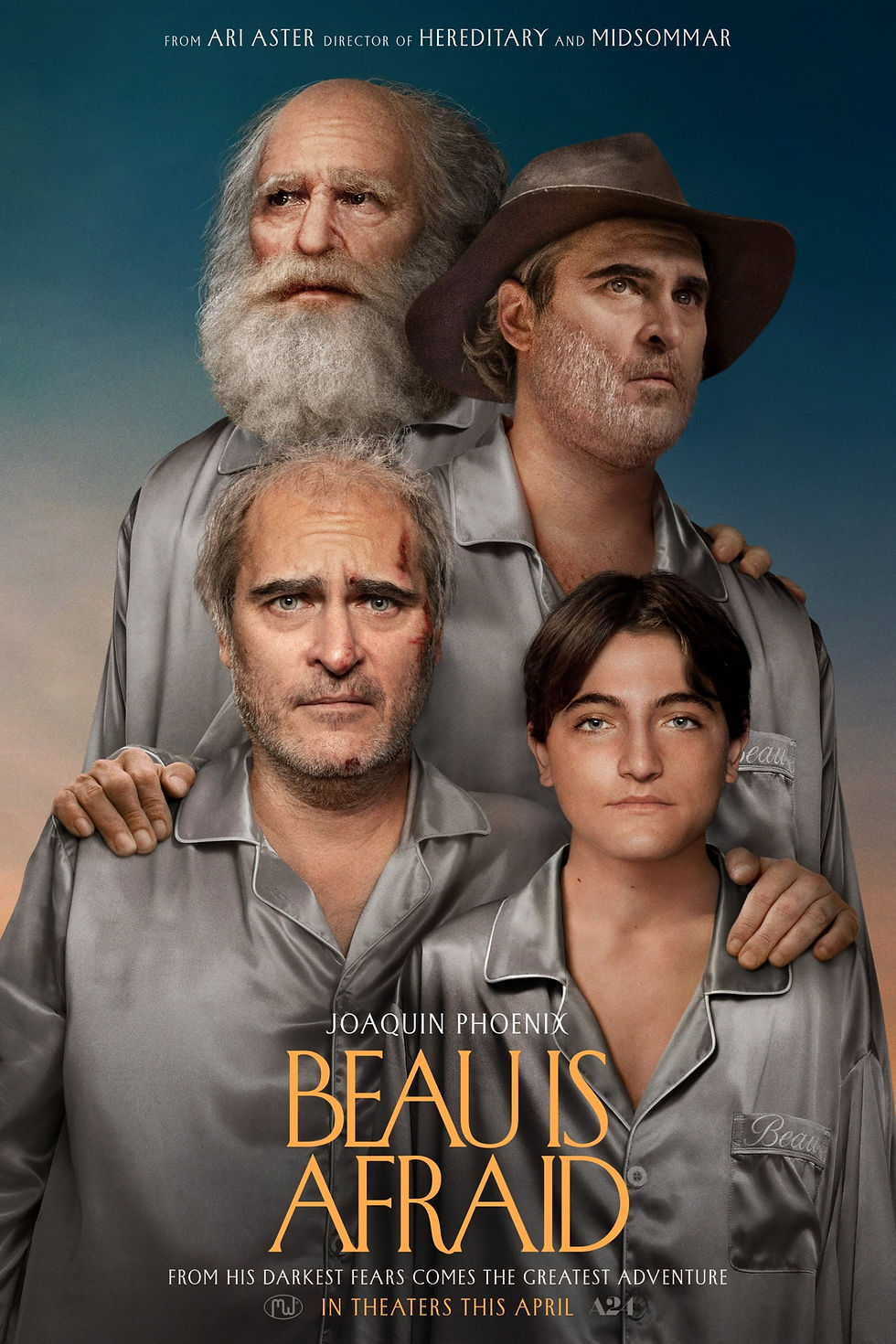
#13 Beau Is Afraid
Ari Aster’s first two films are stonecold horror classics. In fact, the man’s chops are so good he has practically become the poster child for “elevated horror.” You know, that artsy brand of terror which explores psychological themes behind all the gory stuff and traffics in high quality aesthetic choices. So, it seemed to surprise some that with Beau Is Afraid, Aster trotted out…a picaresque??? That’s right! A three-hour odyssey of sorts (from city to suburbs to the wilderness), a harrowing exploration of one Jewish man’s journey through a surreal and hellish landscape of guilt and fear to face his overbearing mother.
Beau Is Afraid is a WILD ride. It takes every single miniscule anxiety of the modern male mind, every frustration at dealing with the plague of mediocrity, and sends it up in virtuosic film language. Maybe I should be clearer – in Beau, Aster takes each of the imagined fears of Beau Wasserman and ACTUALIZES them in the real world. So we get city streets lined with marauders and vagrants, like something out of Walter Hill’s The Warriors, and a father figure which really appears as a phallic monster. There is even an animated sequence which runs through a man’s lineage across generations smack dab in the middle of the proceedings. Obligations. Insecurities. The enduring legacy of generational trauma. This is simply existential dread pushed so far that it becomes darkly hilarious, and then goes even further! Two of my very best friends described it as both uproarious and the cheapest therapy they ever received. I suggest you watch it soon, with that same sentiment in mind.

#12 The Taste of Things
Perhaps what is most interesting to note in reference to France’s The Taste of Things is just how much I liked this film given far I actually am from being a foodie. Not. Even. Close. BUT, I am a total sucker for an extended action setpiece and a heart-on-its-sleeve historical romance if you ever saw one. This is precisely what Taste has in spades. The opening 35 minutes is just one long action scene, only we’ve traded guns and high-speed machinery for kitchen utensils, plates, and pristine cuisine. From the opening shot, director Tran Anh Hung makes his intentions clear. He is out to earn his place in the pantheon of great food movies. So, we witness Juliette Binoche and Benoit Magimel do their dance of endearment across an exquisite kitchen, as they prepare a multi-course meal for the head of the household’s closest friends.
Yet dialogue is so few and far between here. In this cinematic journey, silence often speaks volumes as the characters pour their hearts and souls into their culinary creations. The movie delicately balances romance and tension, eschewing elaborate backstories in favor of a direct and immersive relationship with the food presented on screen. Each dish becomes a metaphor for deeper emotions and connections. Further, the whole affair is illuminated by superb lighting in some of the best cinematography I witnessed all year. And the Taste of Things longstanding love story of two souls whose working relationship has built the most dynamic trust and affection is as poignant as it gets. This is The Taste of Things lasting legacy – a picture which communicates the sentiment that food is not merely sustenance but a language of love and care.
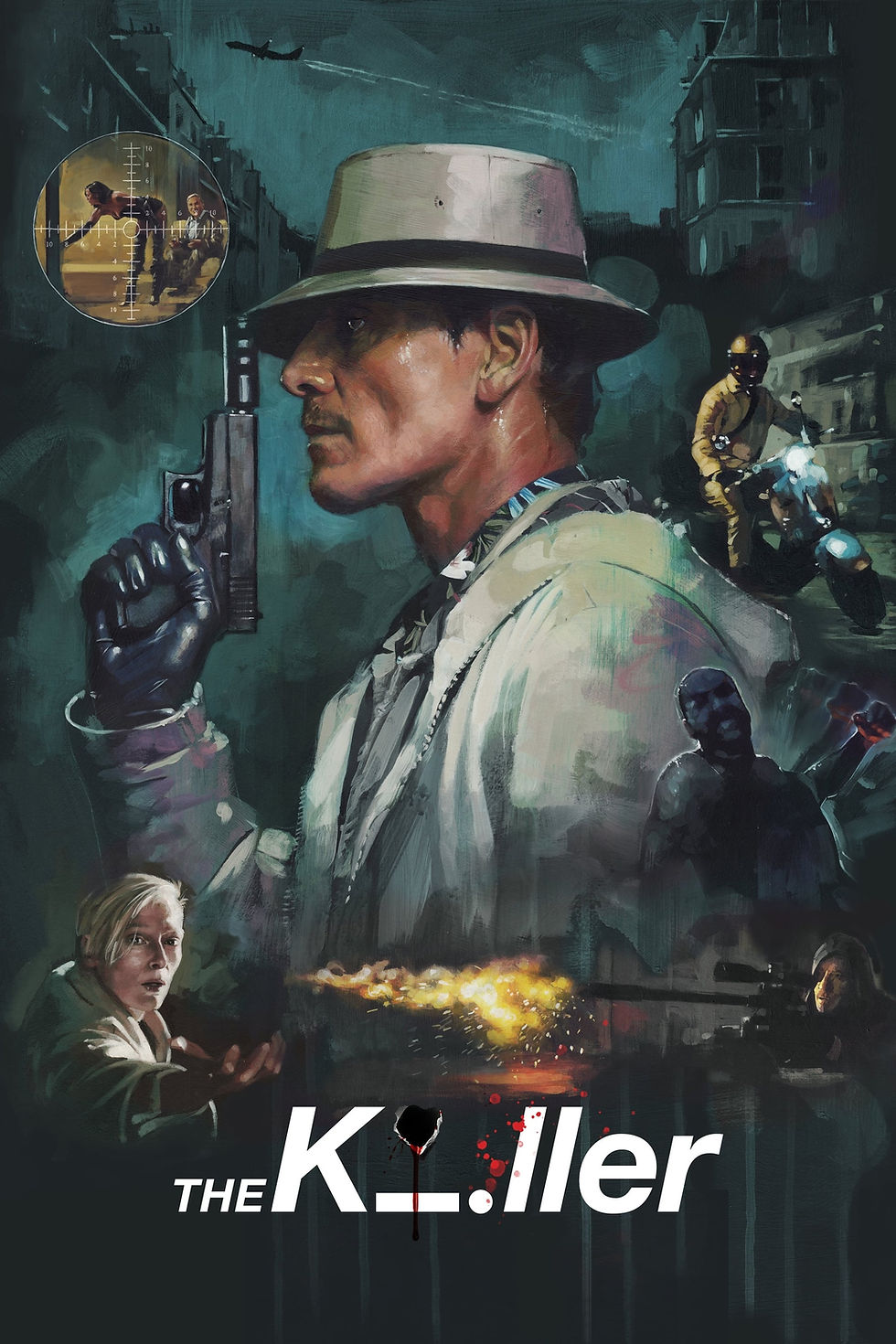
#11 The Killer
Here is a film about a seemingly cold, principled, calculating, and meticulously precise hitman made by a seemingly cold, principled, calculating, and meticulously precise director. Michael Fassbender, meet David Fincher. As I mentioned at the jump, there were more than a few mid-tier works made by powerhouse auteurs this year. What I neglected to include at the time was just how deeply personal some of these pictures were either in their storytelling, or in their reflection of the style and idiosyncrasies of their creators. The Killer belongs to the latter.
On the one hand, it is about as stripped down a work as you’ll get from the likes of Fincher. But sadly, I think this has caused many to miss its greatness. The film delves into themes of control, or more specifically, what happens when the most fastidious practitioners of it begin to lose their grip. Fassbender's portrayal, predominantly through voiceover and subtle facial expressions, captures the essence of a man driven by his perfect mantra yet beginning to show significant chinks in the armor. While not a typical action-packed thriller, The Killer excels in its subdued intensity, punctuated by moments of dark humor (when Fass isn’t deadpanning lines like “Stick to your plan. Anticipate, don’t improvise” he’s spinning cheeky tracks by the Smiths through an old Nano) and a score by Reznor and Ross that pulses with tension.
Yes, it’s true that The Killer may not rank among Fincher's top-tier works. Despite the lack of excessive fireworks, the film's purposeful construction and narrative subtlety make it a compelling watch. It's a departure from typical assassins' journey flicks, offering a more introspective and controlled approach. Yet it still delivers a satisfyingly nuanced experience for those attuned to the director’s distinctive flair.
-Check out a full video review on our youtube channel here.
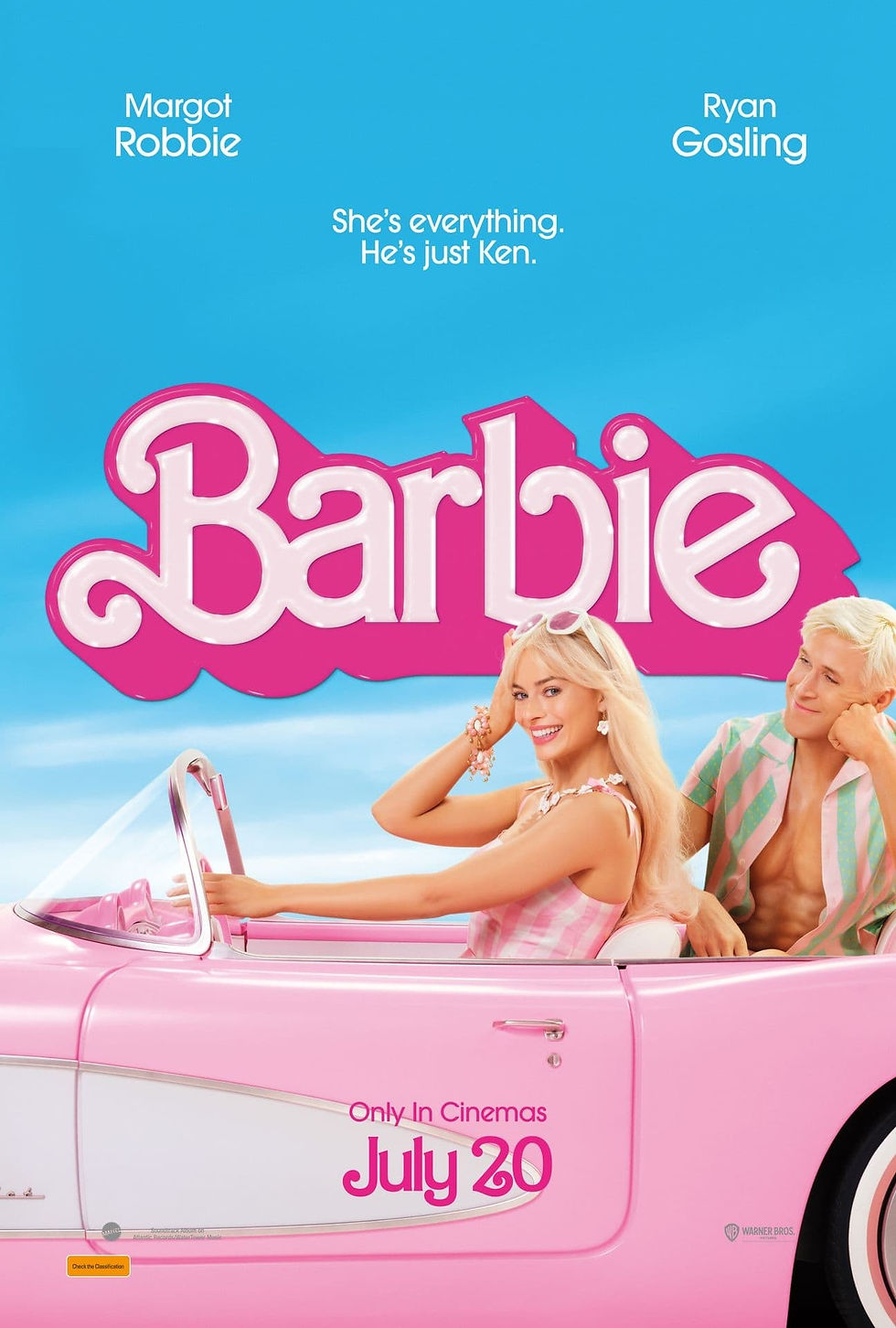
#10 Barbie
I’m tempted to paste the link for my longer diatribe on the entire Barbie experience here and just drop the mic. Truthfully, I’m not so sure I can say anything at this point which is more convincing than what I delineated there at the time. But here goes nothing - Look, you can come at Barbie from about fifteen different angles, and in each one find something to laud and lionize. You want to talk “below the line” work? The production design is top-tier. Barbie’s Dreamworld, created by Sarah Greenwood and set decorator Katie Spencer, is an amalgam of influences ranging from the Matrix to the architecture of Palm Springs (just ask them), housed in a hermetically sealed world all its own. The entire visual conception, complete with song and dance numbers reminiscent of old Hollywood musicals, showcases a remarkable attention to detail. Further, Jacqueline Durran's costume design adds another layer of visual richness.
We could also converse about the powerful emotional stakes of the film. Though it’s now a casualty of death by viral meme-ing, America Ferrara’s monologue on the trials and tribulations of all womanhood remains a Herculean feat. Which is apropos given the strength it conveys, even as it moved so many of us to tears. Ditto Gerwig’s foray into Terence Malick territory, with an ending that affirms the personhood and individuality of this doll from her “creator.”
But if I’m honest, what really blew me away about Barbie was how sharp-witted Gerwig’s script was and how deftly this entire project tackled the cultural landmines surrounding its release. Barbie's bold approach to meeting stereotypes and beauty standards head on is unapologetic. The film's ability to anticipate and subvert criticisms while delivering serious commentary in a fantastical, joyous setting is nothing short of genius. As I said at the time, Barbie is a pop-glitzed romp, a coming-of-age tale, a social satire, and a metacultural commentary all rolled into one. But now, perhaps more importantly, it’s a blockbuster with REAL IDEAS, and we just don’t get very many of those anymore.
-Check out a full video review on our youtube channel here.
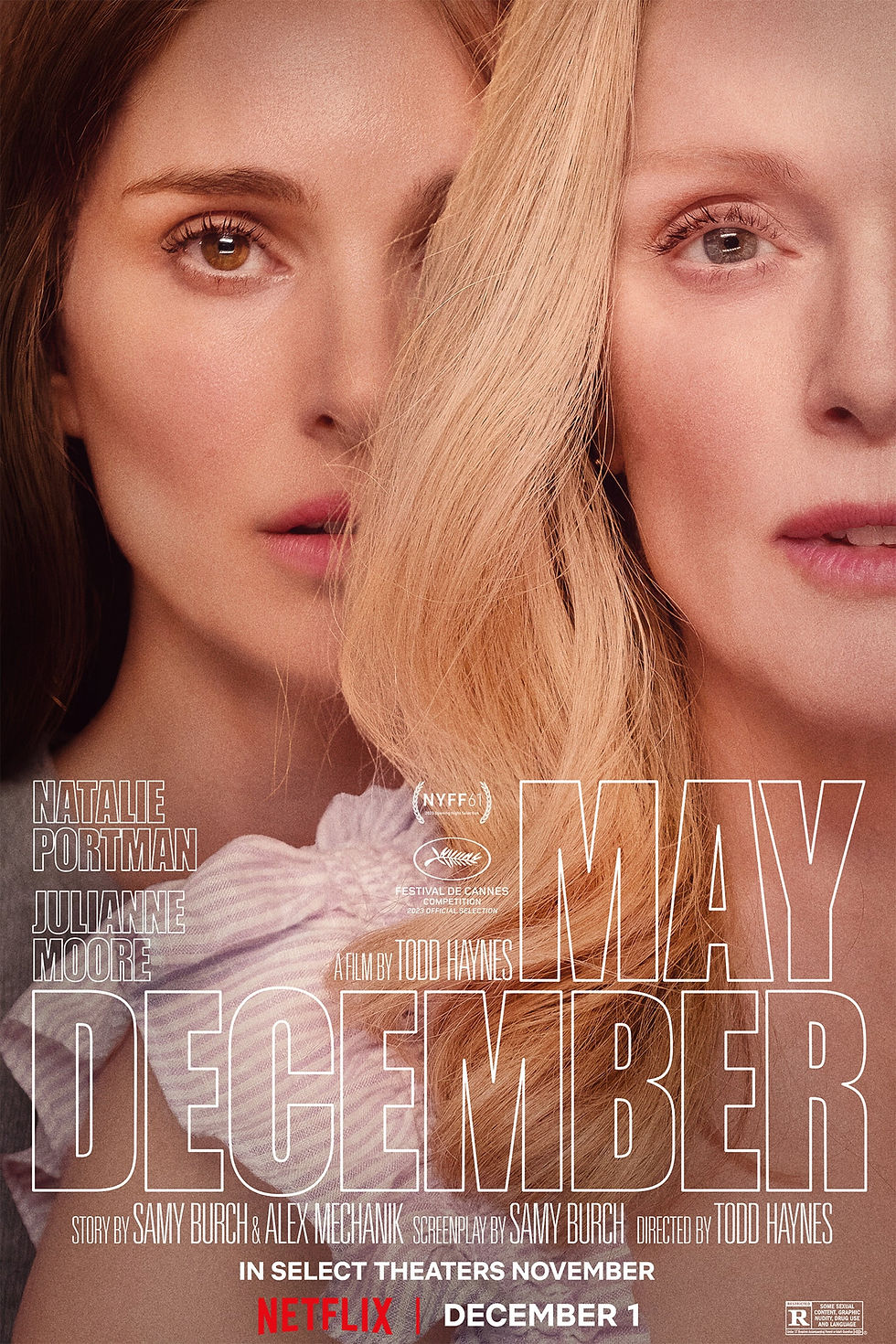
#9 May December
May December is a Todd Haynes' stew of total cringe, high melodrama, and kitschy laughs. This campy confection has “meta” aspects flying at it from all sides. Let’s start with the fact that the whole project is loosely based on the real-life sordidness of Mary Kay Letourneau’s affair (and later marriage) with a minor who was her student. Add to it that Natalie Portman, long known in some circles as a sort of one-note actress, a drama school kid who does as much head-bobbing in her roles as genuine emoting, brought the entire project to Haynes. Then she simply went out and shined brightly as an actress studying a taboo romance. Her performance offers more than a few winks at the audience, as she appears to send up not only herself but the entire enterprise of acting.
Then there’s Julianne Moore, captivating as ever, affecting a lisp and dialing up the drama. Through her, the film explores themes of identity, control, and our culture's obsession with celebrity and true crime. Despite the bigness of the two warring females here, however, it is Charlie Melton's portrayal of a tortured man caught in the middle that really steals the show. Shedding his Riverdale skin to give us a doughy, dad bod husk of a man rounding the corner into middle age, Melton remains trapped in his stolen adolescence. In the long line of films displaying “trauma” onscreen, this is about as good as it gets.
While May December may not satisfy those seeking a scandalous true crime narrative, it excels as a cerebral psychodrama, exploring the complexities of performance versus authenticity. The film's awkward and cringe-inducing moments are balanced with sharp-edged humor. In the end, Haynes and his screenwriter deliver a campy seriocomedy that rings true, propelled by the standout work from its leads.
-Check out a full video review on our youtube channel here.
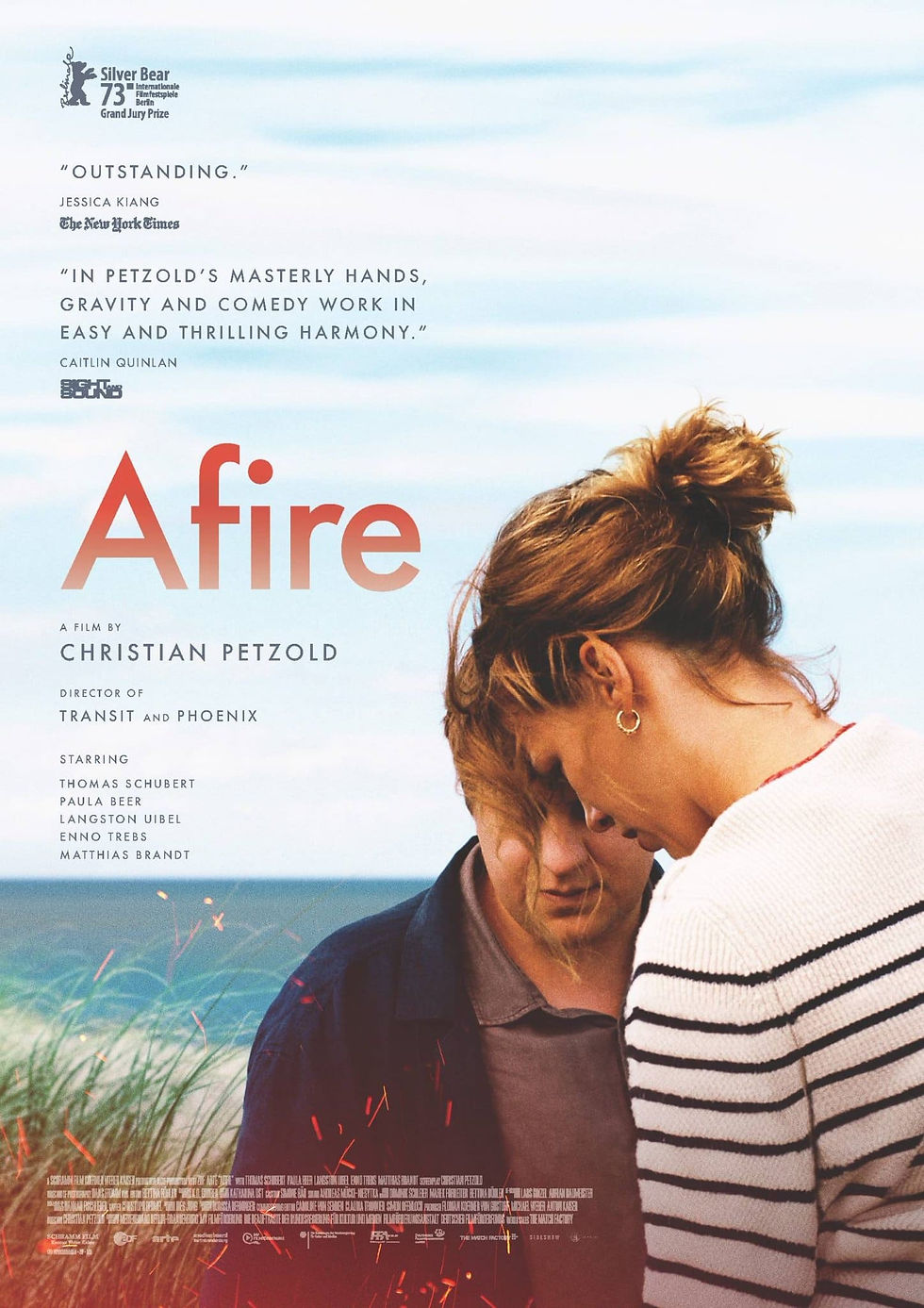
#8 Afire
Afire is simply the best film I saw this year about which almost no one is talking. It has one of the most unlikable “protagonists” in recent memory, yet I could never stop rooting for this dude to get his life together. Leon is a struggling writer who believes he has real talent but is plagued by insecurities about his work. He hopes against hope that his latest manuscript will be embraced with open arms by his publisher, and nearly combusts when Paula Beer’s character tells him in effect that he has penned a piece of hot garbage. Ah, an author plagued by self-doubt. It’s not too hard to discover why I jived with this guy – I am Leon, and he is me.
But Afire has more on its mind besides the creative process. It’s really about two friends who go on a few day retreat on the idyllic Baltic Sea, only to discover that their rental is already inhabited by a beautiful and enigmatic dame. Those familiar with international cinema will note that director Christian Petzhold is really just channeling Eric Rohmer here. Fortunately for us, the facsimile is pretty spot on. So, the film morphs into a riveting exploration of the human condition, wrapped in a narrative that oscillates between introspection and impending ecological crisis (see: the “fire” part of the title above). Petzold draws viewers into a world where the tranquility of a summer retreat belies the emotional turmoil brewing beneath the surface. As the narrative unfolds towards a devastating final act, Afire reveals itself as a poignant and bittersweet meditation on love, loneliness, and the search for meaning in a tumultuous world, cementing Petzold's status as a masterful storyteller in German arthouse cinema.

#7 The Zone of Interest
Jonathan Glazer's The Zone of Interest is hardly even a movie. No, it’s more of an immersive EXPERIENCE that challenges viewers to confront the banality of evil and humanity's capacity for indifference in the face of the most heinous atrocities. In terms of plot, this is just the story of a nice, middle class German family searching for their own version of the idyllic dream – kids, house, garden, watering hole, and clothing and jewelry showing up on demand. There is, of course, one difference from the other films of this ilk, which soon becomes apparent. That is, well, the other side of that wall next to their personal Shangri-La is the death camp Auschwitz, and our strapping leading man is none other than Rudolf Hoss, ruthless commandant and Nazi war criminal.
The performances here are roundly solid, but the real wonder of Zone is in the clarity of Glazer’s directorial vision. He constantly seeks to modernize the past through innovative visual and audio techniques, like static cameras placed throughout the couple’s house or nighttime sequences using thermal imaging. The sound design offers us our SOLE glimpse at the world outside the walls, as we hear the machinations of trains and ovens, occasional gunshots and screams. The effect of all of this is to force the viewer to grapple with uncomfortable truths about the insidious nature of evil today. NOW. We can no longer distance ourselves from the events as being merely “of the past.” By making the absolutely brilliant choice to show the audience almost nothing (after all, how can one really capture and properly pay homage to the true depth of horror experienced in that camp), Glazer has left us with an artifact that hangs with us long after the credits roll.
-Check out a full video review on our youtube channel here.
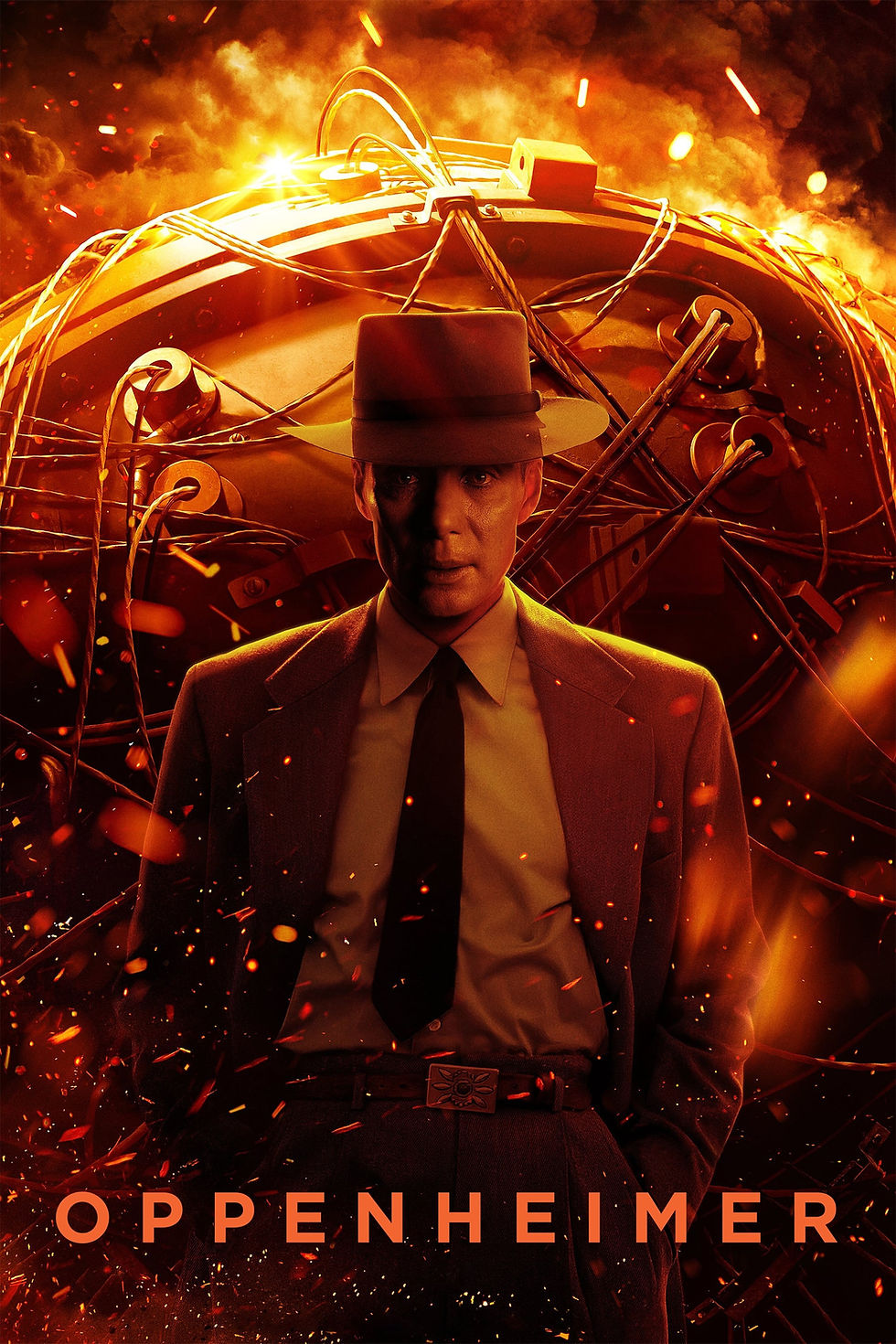
#6 Oppenheimer
Oppenheimer is a film that continues to both confound and leave me in awe all at once. It’s like your standard book adaptation of a historical figure got NOLANIZED! (Do you like it? I just coined it. Maybe still workshopping…) Which is to say, got punched up into something approaching colossal scale, and dissected and twisted about into a tripartite narrative structure which is as ambitious as it is, well, occasionally pointless. In every, and I do mean every, below the line category Oppenheimer is nearly transcendent. We’re watching the story of a man inventing a bomb among his colleagues, so we get a lot of the frequent cutting, “important men talking in a room” crackling dialogue. But then there are myriad cutaways into interstitials of booming sound and fulminating visuals. Soon it becomes clear that besides disorienting the viewer, Nolan and cinematographer Hoyte Von Hoytema (what a fricking name!) have another purpose in mind, namely to create the viscera surrounding the detonation of a bomb.
Then, of course, about 2/3 of the way in, we actually get one of those! I don’t believe it’s a spoiler at this point to say that the Trinity Test is absolute high-water mark filmmaking on that level of spectacle. Jennifer Lane crushes all of this editing, and Ludwig Goransson’s score adds weight and gravity to all of the events unfolding. Furthermore, if you watched the big show, you probably know that Oppy showcases a cadre of stellar performances alongside this impeccable sound design and daring narrative structure. Cillian Murphy has never been better, his captivatingly haunting visage filling up so much of the frame. Damon is hamming it up, bringing comic relief like he's almost in a different movie, and RDJ has at last found himself another compelling turn sans comic book get-up. Only Florence Pugh and Emily Blunt are underutilized here, but that seems to be in service to Nolan’s greater intentions. Whatever my small quibbles, Oppenheimer remains a tour de force, showcasing Christpher Nolan's ability to reinvent historical narratives and captivate audiences with his unparalleled cinematic vision.
-Check out a full video review on our youtube channel here.

#5 Poor Things
A steampunk coming-of-age Frankenstein-ian sex comedy, directed by a Greek, and financed by…Walt Disney Studios!!!
Do I need to say anything more?!
Fine, I will. Yorgos Lanthimos is quickly becoming my king. With Poor Things, he once again proves himself to be a filmmaker who defies categorization, delivering a cinematic experience unlike any other. This time around, the director blends elements of monster flicks, coming-of-age dramas, and even rom-coms into a delightfully absurd concoction that keeps audiences guessing at every turn. His visual palette is the kind of confection, consisting of equal nods to the macabre, surrealism, and whimsy, that would make the likes of Tim Burton proud. And Tony McNamara’s audacious screenplay is side-splitting throughout the film’s runtime. Couple all this with inventive cinematography and exuberant costume design, and this man’s works are nearly without peer.
But what really makes Yorgos’ singular vision hum is the talents of this stellar cast. I’ve simply NEVER seen Mark Ruffalo be this hilarious or stupidly winning. He portrays an exceedingly confident man about town whose bravado is so successfully eroded in each successive sequence by the wiles of Bella Baxter that he ultimately becomes a husk of a human being. I simply never saw this kind of turn from Ruffalo coming. Willem Defoe is always sturdy as an oak, here granting us a mad scientist whose ridiculous gastric bubble-blowing belies a heart of gold. Still, let’s face it, this is Emma Stone’s show, and she is nothing short of transcendent. From the opening moments, where she stumbles around the doctor’s dark mansion like an adult toddler, to her discovery of everything from sexual delight to the wonders of travel and the triumph of the will, she is utterly captivating. Her personal voyage, like the film which surrounds her, is a journey from physical comedy to profound emotional depth.
-Check out a full video review on our youtube channel here.
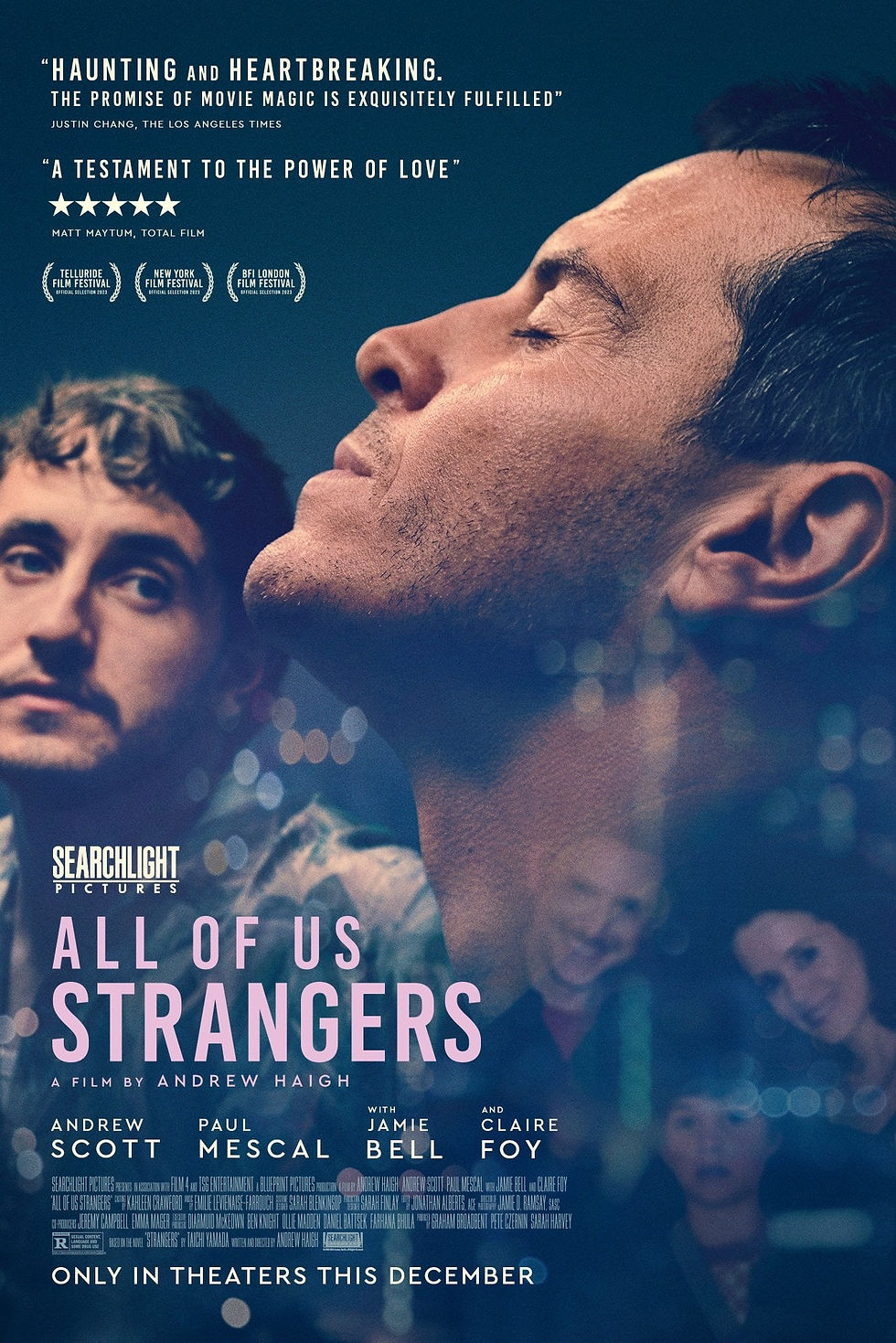
#4 All of Us Strangers
Imagine a world where you, approaching middle age, could take a ride on a train to your old hometown. When you arrived, your parents would be there waiting for you. But they wouldn’t be old and gray. Instead, they’d be your current age, the age when you last saw them as a 12 year old kid before they left this world. This is the remarkable premise of All of Us Strangers, one whose potential for meaningful conversations is rife. The film is a journey of coping with loss and opening oneself up to living fully and loving again. It’s directed by Andrew Haigh with a very minimalist and tender approach (read: LOTS of lengthy close-ups). This, when coupled with the film’s lonely, dreamlike atmosphere, creates an immersive experience which lingers with the viewer.
All of Us Strangers is about loneliness and isolation, forlorn people searching for connection. It features a duo of terrific actors, Jamie Bell and Claire Foy, who each add nuance and their own foibles to their depictions of the protagonist’s parents. Paul Mescal, whose meteoric rise is all but in the bag at this point, represents the possibility of new beginnings, of a wounded heart opening. But none of this works half as well as it does if Andrew Scott is not the all-surpassing powerhouse of grief and yearning embodied that he is here from bow to stern. This is a vulnerable film that is softly shattering. A personal ghost story about the colossal absences left in us when loved ones depart, and how that can shape our entire existence into the future if we’re not careful. It’s an incredible marriage of mood and content, and a veritable fountain of measured yet mammoth performances by its four leads. A film that, in the end, is crushingly sad yet somehow supremely hopeful.
-Check out a full video review on our youtube channel here.

#3 Killers of the Flower Moon
Martin Scorsese has got some stones, man. I’m talking chutzpah for days. When I look at Killers of the Flower Moon in totality, I’m just not sure how the octogenarian pulled it off. He took David Grann’s acclaimed book about the genocide of Osage peoples by avaricious whites seeking claim to land offering bountiful oil reserves, and completely morphed it. This is a story which is honestly about the rise of the FBI, yet in Marty and fellow writer Eric Roth’s hands, it became a lengthy examination of the forces of evil shone through the microcosm of one single couple. Of course, it helps greatly when the male part of that duo is the nearly-bats-.1000 Leo DiCaprio playing a bumbling dolt for the first time, and the female is the captivating Lily Gladstone. Regarding the latter, I’m actually still trying to parse how someone who could be onscreen so little and say even less could act as soul and central magnetic force for the entire work.
But the real ticket here is that this is still much more of a Scorsese jaunt than originally meets the eye. Oh, we’ve still got gangsters offing people with head shots and mobsters with underlings running operations. It’s just this time around, the kingpin is an avuncular townsperson who plays philanthropist by day and scheming weasel by night. I’ve said it before, and I’ll say it again now – this is one of the greatest of all De Niro performances. How he manages to be more sinister here than in Casino and Goodfellas, all while donning glasses, a hat, and that grandfatherly grin, is quite beyond me.
Regardless, Killers takes the old Scorsese thematic showtunes of men’s battle against evil and the quest for salvation and just gives it a new lacquer coat. Soon the film begins to look a lot like his other late-period works (Silence, The Irishmen) – spacious explorations which really take their time to examine the WEIGHT of violence, both in its physical destruction and its capacity to eviscerate the human soul. Still, maybe the most affecting moment of all is the film’s coda. The sequence when Oz steps out from behind the curtain. The humility on display then will stay with me for ages, as will this entire thought-provoking exploration of America’s dark past and the enduring legacy of its victims.
-Check out a full video review on our youtube channel here.

#2 Anatomy of a Fall
Don’t you just LOVE those double entendre titles, guys? Well, that’s exactly what we’re working with here. The titular “fall” is indubitably in reference to the husband who took a header out the third story window of his French Alps chalet to his death. But there is also a more probing reference point, which is closer to the center of what writer/director Justine Triet is truly examining in Anatomy of a Fall – the devolution of a marriage. A couple’s fall from grace into ruins. It is THAT which begins to take centerstage once Anatomy speedily morphs from murder-mystery into French courtroom bonanza.
If you’re like me, you readily recall the 90’s swath of lawyer paperbacks and resultant blockbuster flicks from the likes of John Grisham et al. In these lesser works, there was always drama and intrigue, attorneys violating client privileges to get a little too close to those on the stand, and courtroom fireworks to hold the viewer’s attention. Triet’s work may be somewhat indebted to that ilk of popcorn fare, but it leaves it in the dust when she really puts her foot on the accelerator (the car references are back, Furman?) The acting in this court, the discussions, the stops and starts and interruptions, it’s all unparalleled. And at the center of it all is one of the most quietly devastating performances you’ll see all year through the haunted visage of Sandra Huller.
I’ve spoken at length elsewhere (see video link below) about all the inspired directorial choices Triet makes throughout the film’s runtime, in terms of editing, what she chooses to put onscreen visually as certain audio plays, and a dozen other deft touches. But the crucial fact is that you just don’t get a marriage of performance, writing, and auteurist vision like what you see on display here. The film is so good at constantly keeping the viewer guessing (DID SHE DO IT OR NOT?!) while actually subverting the entire central question into a larger exploration of relationships. It’s a classic bait and switch if I’ve ever seen one, and in these able hands, it actually works! Anatomy of a Fall is a testament to the power of cinema to provoke thought and spark conversation, leaving audiences questioning their own perceptions of truth and reality in the wake of one woman’s quest for justice.
-Check out a full video review on our youtube channel here.

#1 Past Lives
“In-Yun” is a Korean belief that essentially states that an individual’s previous lives reverberate through the layers of time until they finally coalesce in an instant when two people find each other. So, in terms of brass tacks, this means when people connect in this world, it is because of a series of minute encounters that they’ve made throughout all of their other lifetimes. “In-yun” is the string which tangles us together across time and space. Now this concept may seem a little heady, overly mawkish or hopelessly romantic (the latter of which I decidedly am), but not in first time director Celine Song’s able hands. In Past Lives, Song always has the picture balanced perfectly between this gut-wrenching ache and the ability for these characters to laugh at the seeming ludicrousness of human existence.
Here is a film that reminded me of David Lean’s Brief Encounter, little nudges of Linklater’s Before trilogy, and a healthy dose of the heart-longing of Wong Kar Wai. It’s an astoundingly assured debut. Each of the performances of the three leads are tender, delicate, even somewhat hushed. There are no wild histrionics, rather just lived-in characters. But what makes this all so extremely engaging to the viewer is just how grown up they all behave. Here are two deeply connected childhood friends wrested apart when the girl’s family emigrated from South Korea to Canada who have now reconnected two decades later in New York City. Yet in that interim, Nora (the girl) has found a husband and a happy life in a new culture. This is an immigrant’s tale, a story about love and life left behind in one place and then discovered anew elsewhere.
In the course of this reunion, Past Lives examines themes which resonate with so many of us - the comfort of established relationships versus the fear yet exhilaration of the unknown. The lingering what-if’s of “the one that got away.” In essence, the whole project smacks of the real ups and downs of relationships, the ways that people discover themselves and each other. In the end, this is a far cry from the exercises in lunacy which punctuate so many romantic comedies. No, Past Lives is an adult love story that feels powerfully real. Full of intricately sketched characters yet somehow plumbing the depths of the human condition, it is a meditation on the complexities of human relationships and the inexorable pull of destiny. It is undoubtedly my best film of this past year.
-Check out a full video review on our youtube channel here.
Honorable Mentions:
Fallen Leaves
Perfect Days
Talk to Me (video review here)
John Wick: Chapter 4 (video review here)
The Holdovers (video review here)
You Hurt My Feelings

Comments